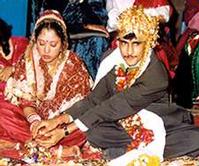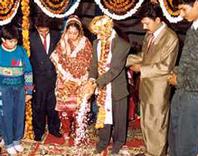THE MARRIAGE CEREMONY OF THE HINDUS
Introduction

Marriage in the
Hindu religion is the 13th of the 16 ceremonies in a person's life. It is a
sacrament and as such is solemnised in accordance with the VEDAS, the holy
scriptures of the Hindu religion that date back several thousand
years.
Hindu Ceremonies
seem to last for hours, days or even weeks. Although the wedding itself is held
on one day, there are a number of ceremonies that are usually held on separate
days preceding the wedding:
Engagement (Misri)
the Ring Ceremony) - this event is held to exchange the gold wedding rings. The
couple welcome each other with garlands and sweets are exchanged between the two
families. The engagement is often completed a dinner party for friends and
relatives. Among Gujarati families the bride's family presents the 'Matli',
which consists of
significant quantities savoury snacks and Indian sweets, to
the groom's.
Mehndi Party

- This is a festive occasion celebrated by
the bride's family. The bride and close female members of her family have henna
painted on their hands and feet while the rest of the family celebrate with
songs. Mehndi signifies the strength of love in a marriage so brides try to
leave it on as long as possible! Mehndi parties are often held at home and end
with dinner for the family and friends.
Raas Garba (Sangeet Party)
In many families, the
Sangeet Party is a much larger affair held as a separate joint event for both
families. It is an opportunity to sing songs, eat, drink and dance the night
away. Among Gujaratis, Raas Garba is a favoured alternative. These are held in a
hall and involve traditional dance (Garba), and dandia raas (dancing with
sticks). The Raas Garba usually ends with a light supper for all those
attending.
Ghari Puja
This is a religious ceremony performed on
the eve of the wedding day in the respective homes of the couple. The priest
performs prayers with rice, coconut, wheat grains, oil, betel nuts and turmeric.
During this event, the mother and close female relatives dress up in their
finery. They carry earthenware pots of water on their head and plant a small
stalk in their garden in celebration of the marriage. Nowadays, the Ghari Puja
is often combined with the cleansing ceremony (Pithi) during which the bride and
bridegroom are pasted with turmeric powder in a beautification
process.
Outfits & Jewellery
The bridal outfit consists
of a red and white sari heavily embroidered with gold thread. The white
signifies purity and the red signifies fertility. It is customary for the
bridegroom's family to gift the bride a wedding sari, so she may actually end up
wearing two saris! The first, a simpler silk sari given to her by her maternal
uncle (mama), and covering her head, a heavier embroidered sari given to her by
her husband's family. The groom also wears white (ivory or beige). His outfit
can be a traditional Sherwani (long tunic embroidered with gold thread) worn
with Kurta pyjamas, or a simpler dhoti and tunic. Both families use the occasion
to wear their finery and much of their traditionally ornate gold jewellery. This
is not custom, so much as fashion!
The Wedding Ceremony
The wedding day
usually commences with a fast for both the bride and groom. The groom will leave
his house accompanied by his best man and one of his younger female relatives
whose job it is to keep the groom awake by shaking a metal pot filled with a few
coins and a betel nut over his head. The history behind this curious custom is
that weddings in India were traditionally held in the evening at which time many
a groom might succumb to slumber!
On leaving his
house, the groom's car may be impeded by the younger female members of his
family who demand a "gift" in exchange for allowing him to leave for his wedding
ceremony.
The majority of the
wedding ceremony will take place in a Mandap (the four-pole canopy at centre
stage). The sacred fire in the Mandap symbolises not only the illumination of
the mind, knowledge and happiness but is also a clean and pure witness to the
ceremony as it progresses.
The ceremony itself
is a collection of rituals performed by the bride, bridegroom and their
respective parents and close relatives. The priest chants "mantras" from the
Vedas that were originally written in Sanskrit. He will also use the following
in his ceremonies:
- Fresh flowers - to
signify beauty;
- Coconut - to
signify fertility;
- Rice, jaggery and
other grains - to signify the food necessary for sustenance of human life;
- Ghee (purified
butter) - to feed the sacred fire;
- Kumkum (vermilion)
- red powder used for marking the forehead to signify good luck and to say that
your soul (husband) is with you.
The major stages of
the Hindu Ceremony:
Ganesh Puja
The wedding day starts with a prayer
invoking Lord Ganesh whose divine grace dispel all evils and promotes a
successful and peaceful completion of the ceremony.
Grah Shanti(Worship to the Nine Planets)
This is a
prayer to the nine planets of our Solar system. Ancient Indian studies indicated
that various celestial bodies have an influence on the destiny of every
individual. The effect of the nine planets is meant to be the most profound.
During this puja the Gods associated with these planets are asked to infuse
courage, peace of mind and inner strength to the bride and groom to help them
endure life's sufferings.
The Welcome (Parchan)
The bride's mother welcomes
the bridegroom with a garland and she then escorts him to the mandap. The father
of the bride washes the right foot of the bridegroom with milk and honey. At the
end of the welcome, a white sheet is held to prevent this bridegroom seeing the
arrival of the bride.
Arrival of the Bride
The bride is escorted to the
mandap by her maternal uncle (Mama), female cousins and friends. In some wedding
ceremonies she may be carried in a small carriage to the mandap.
Kanyadaan (Entrusting of the
Daughter)
Consent of the parents is obtained for the wedding to
proceed. The bride's parents give their daughter to the groom by putting the
bride's right hand into the groom's right hand (Hastamelap, joining of hands)
while reciting sacred verse. The curtain separating the bride and groom is then
lowered and the couple exchange flower garlands. The elders of the house place
an auspicious white cotton cord around the couple's shoulder's to protect them
from the evil influences. This also symbolises the couple's bond. The groom
holds the bride's hand and they both take vows to love cherish and protect each
other throughout life.
Ganthibandhan(tying the knot)
The priest ties the wedding knot as a symbol of the permanent
union between the bride and groom as husband and wife.
Agni Puja (evocation of the holy
fire)
The priest sets up a small fire in a kund (cooper bowl). Agni
(fire) is the mouth of Vishnu and symbolises the illumination of mind, knowledge
and happiness. The remainder of the ceremony is conducted around the
fire.
Shilarohana(stepping on the stone)
The bride places her right foot on a stone. The bridegroom
tells her to be as firm as the stone in his house so that the can face their
enemies and the difficulties of life together.
Laja homa (putting parched rice into the sacred fire)
Three obligations are offered to the sacred
fire. The brother of the bride puts into the bride's hand parched rice, half of
which slips into the bridegroom's hand. Mantras are chanted. The bride prays to
Yama, the God of Death, that he grant long life, health, happiness and
prosperity to the bridegroom.
Mangalfera (walking around the fire)
The couple walk around the sacred fire four times. Each time
they stop to touch with their toe a stone in their path. This symbolises
obstacles in life that they will overcome together. These four rounds stand for
the four basic human goals:
-
Dharma - righteousness
-
Artha - monetary accomplishment
-
Kama - energy and passion in life
-
Moksha - liberation from everything in life.
The groom,
signifying his contribution in helping the union to attain dharma, artha and
kama, leads the first three rounds. The bride signifying their continual journey
spiritual liberation leads the last round.
Saptapadi (seven steps)
The bride and groom take
seven steps together around the fire. It is said in Hindu philosophy that if two
people walk seven steps together then they will remain lifelong friends. They
exchange sacred vows at the beginning of each encircling walk. At the end of
each walk, the open palms of the bride are filled with puffed rice by her
brother signifying wealth and prosperity. The seven steps and their promises
are:
1.Let us take the
first step to provide for our household, keeping a pure diet and avoiding those
things that might harm us.
2. Let us take the
second step to develop our physical, mental and spiritual powers.
3. Let us take our
third step to increase our wealth by righteous and proper means.
4. Let us take out
fourth step to acquire knowledge, happiness and harmony by mutual love, respect
and trust.
5. Let us take the
fifth step so that we may be blessed with strong, virtuous and heroic
children.
6. Let us take the
sixth step for self-restraint and longevity.
7. Let us take the
seventh step to be true companions and remain life-long partners by this
wedlock.
Saubhagya Chinha (blessing the bride)
The bridegroom blesses
the bride by putting kumkum or sindhur (vermilion powder) at the parting of her
hair (or on her forehead) and by giving her a sacred necklace (Mangal Sutra).
The Mangal Sutra represents the couple's togetherness, love and sacred
union.
Aashirvaad (blessings)
The priest blesses the
bride and groom. Flower petals and rice are given to the guests to shower them
on the bride and groom with blessings. The wedding guests can then give their
individuals blessings to the bride and groom and once completed, the marriage
ceremony ends. Guests are invited to enjoy a sumptuous meal with the
newlyweds.
Vidai (Bride's departure)
The farewell to the
bride by her family and friends is a very emotional episode. The bride is
leaving her parents home to build a life with her husband and his family. She
leaves with tears of joy and sorrow.
Pilucinchuanu
Before the wedding car
departs for the Hindu temple, the priest will place a coconut under the front
wheel of the car and wait for it to be broken by the weight of the car. The
historic significance of this is that in the old days the couple would use a
horse drawn carriage and the breaking of the coconut ensured that the vehicle
was roadworthy for the journey.
The pilucinchuanu
concludes the entire ceremony.
|



